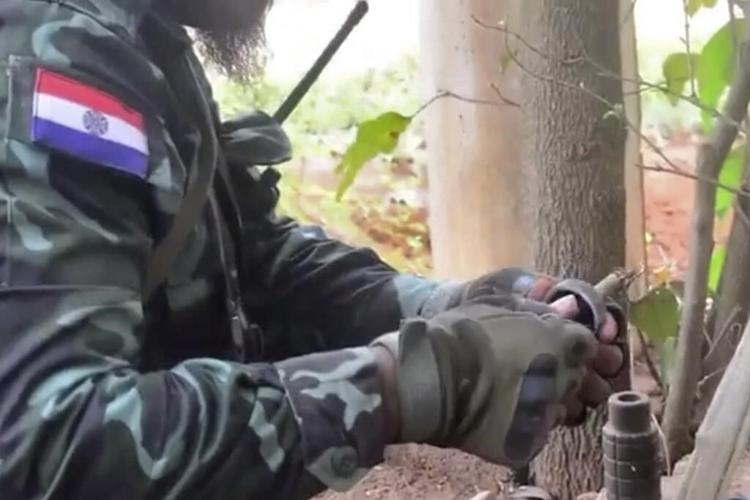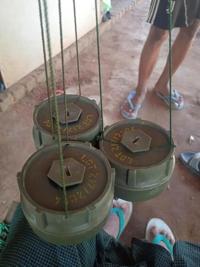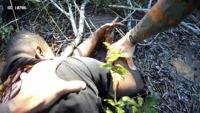BANGKOK (AP) — The 3-year-old boy had taken only two steps from his mother’s lap when a deafening explosion rang out. The blast caught the woman in the face, blurring her vision. She forced her eyes open and searched for her son around the jetty where they’d been waiting for a ferry, near their small village in south-central Myanmar.
Through the smoke, she spotted him. His body lay on the ground, his feet and legs mangled with flesh peeled away, shattered bones exposed.
“He was crying and telling me that it hurt so much,” she said. “He didn’t know what just happened.”
But she did.
___
The boy had detonated a landmine, an explosive device designed to mutilate or destroy whatever comes into its path.
Landmines have been banned for decades by most countries, since the U.N. Mine Ban Treaty was adopted in 1997. But in Myanmar, which isn't party to the treaty, the use of mines has soared since the military seized power from the democratically elected government in February 2021 and armed resistance
Landmines are planted by all sides of the conflict in Myanmar, and they’re responsible for surging civilian casualties, including an alarming number of children as victims, according to an AP analysis based on data and reports from nonprofit and humanitarian organizations, interviews with civilian victims, families, local aid workers, military defectors and monitoring groups.
In 2022, U.N. figures show, civilian casualties from landmine and unexploded ordnance spiked by nearly 40%. Experts say this and other official tallies are vastly undercounted, largely due to difficulties monitoring and reporting during the conflict.
Despite incomplete numbers, experts agree the increase in Myanmar is the largest ever recorded.
Virtually no area is immune to the threat. Over the past two years, mine contamination has spread to every state and region except for the capital city, Naypyitaw, according to Landmine Monitor, a group that tracks global landmine use.
The military also uses civilians as human shields, a practice widespread in the country for decades but raising alarms with increasing mine incidents. AP's analysis found the military, known as the Tatmadaw, forced people to walk ahead of troops to detonate potential landmines in their path, protecting their own troops.
The Myanmar military, which has acknowledged mine use in the past, didn't respond to a list of questions AP sent to their official spokesperson's email.
When the fighting moves on, landmines don’t. Mines left behind can indiscriminately maim or kill those who happen upon them, years later.
It raises the specter of casualties for years to come. In countries including Egypt and Cambodia, people continue to die from millions of mines left behind long after conflicts has ended.
___
“Leaving an activated mine like this is the same as releasing a monster,” said a 26-year-old military defector who worked as a combat engineer platoon commander in Myanmar.
Like most who were interviewed by AP, the defector spoke on condition of anonymity to protect himself and his family from military retaliation.
Landmines and unexploded ordnance have been a persistent issue in Myanmar for more than four decades. The problem has grown exponentially since the military takeover, with heavier use of landmines in more parts of the country, said Kim Warren, a U.N. landmine specialist.
In 2022, 390 people were victims of landmines and unexploded ordnance in Myanmar, more than a 37% increase from 2021, compiled by UNICEF. Overall, 102 people were killed and 288 were wounded, with children making up some 34% of the victims, compared with 26% in 2021.
Still, Warren said, incidents are underreported.
Yeshua Moser-Puangsuwan, Landmine Monitor’s Myanmar expert, said his group counts only casualties it can confirm with confidence: “We’ve always been undercounting.”
Experts concede the total number of casualties may seem small, with Myanmar’s population of about 56 million, but say the rapid increase is distressing nonetheless. Experts are particularly concerned about children victims. Many are unaware of how lethal landmines and unexploded munitions are; some pick them up and play with them.
Many civilian victims encounter landmines during daily routines.
___
In March 2021, two teenage cousins were working on a small family-run plot in Shan state. They'd just left to dig for sweet potatoes when the father of one of the boys heard a blast. He rushed to help but was too late. They'd been killed instantly. They'd triggered a mine.
The father, 47, tears up when he returns to the fields.
“But it’s my family’s business, so I have to come to the farm to make a living,” said the man, who spoke on condition of anonymity to protect himself and his relatives.
Many victims and families won't know who was responsible for the blasts — the Tatmadaw or anti-military groups.
A member of a militia that operates in Sagaing said his group has removed nearly 100 mines thought to be planted by the military and plans to reuse them to augment its arsenal of homemade devices.
“A mine is an indispensable weapon to attack the enemy,” said the member, who spoke by phone on condition of anonymity over the sensitive information and fear the military would retaliate against his family.
One man in Myanmar’s western Chin state described how soldiers took him, his pregnant wife and their 5-year-old daughter captive, making them and 10 other civilians walk ahead, beating them with rifles if they refused.
“I thought: ‘Today is the day I die,’” said the man, who also spoke on condition of anonymity for fear of reprisal. They escaped — no mines detonated during their march.
Landmine Monitor documented similar incidents in other states, calling it a “grave violation of international humanitarian and human rights law.”
Myanmar and Russia were the only states documented to have used mines in 2022, according to Landmine Monitor.
The group also confirmed the military has been increasingly mining infrastructure such as mobile phone towers and power lines to deter attacks. Military-planted mines also are protecting at least two major Chinese-backed projects — a copper mine in Sagaing and a pipeline pumping station in northeastern Shan state that is part of China’s Belt and Road initiative, Moser-Puangsuwan said.
“We are not aware of the situation you mentioned," a spokesperson for China’s Ministry of Foreign Affairs wrote to the AP in a fax. "The cooperation project between China and Myanmar is in line with the common interests of both sides and has brought tangible benefits to the people of Myanmar.”
It made no reference to any of those who'd been maimed.








































